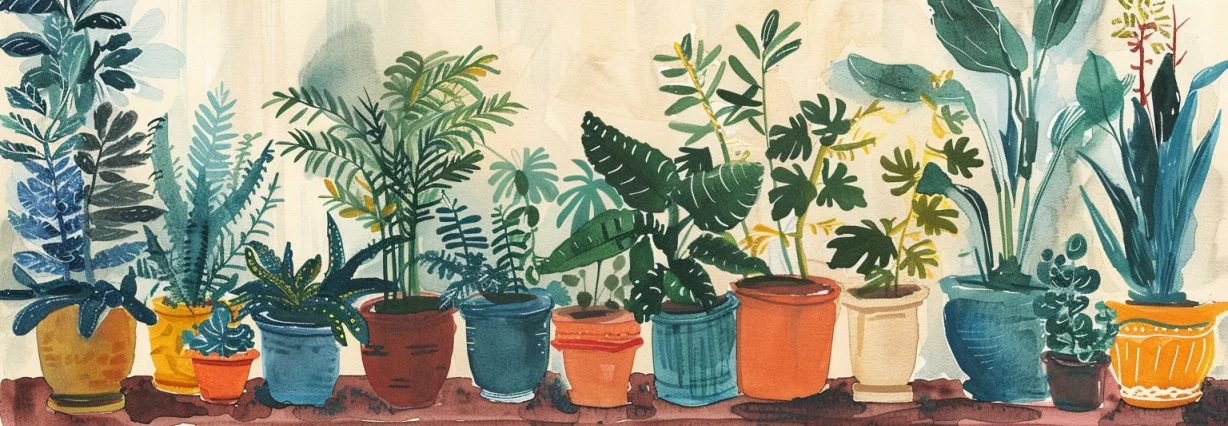Potted Cactus Care calls for a consideration of their unique needs and challenges.
While these hardy plants are known for their resilience and low maintenance, they are not without issues that can undermine their health and aesthetics.
The key to successful cactus care lies in understanding their natural desert habitats, which provide clues to their preferred growing conditions.
In their native environment, cacti thrive in well-drained soil, experience infrequent rainfall, and bask under the full sun.
Mimicking these conditions within a home or office setting will create a conducive environment for a potted cactus to flourish.
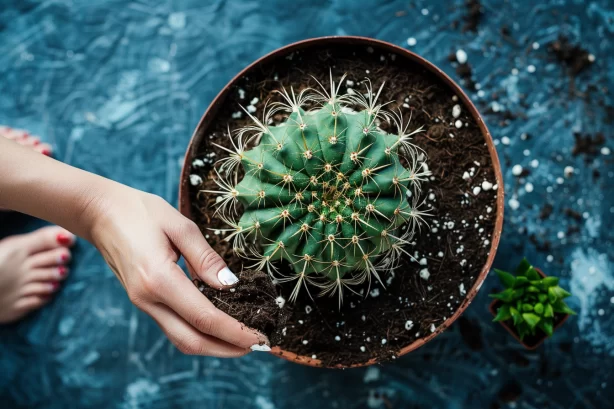
Within the confines of a pot, the specific care requirements become more acute.
Ensuring proper drainage and avoiding overwatering is critical, as these plants are susceptible to root rot when left in moist conditions for too long.
Many common issues faced by potted cacti, such as softening or discoloration, often stem from water-related problems.
Moreover, potted cacti still require access to ample light, and even though they are drought-tolerant, they benefit from a proper watering schedule and occasional feeding during their growing season.
To prevent and manage potential problems, it is important to observe potted cacti closely and adjust care routines as needed.
Early detection of pests, diseases, or environmental stressors allows for timely interventions that can rectify issues before they escalate.
Selecting the Ideal Pot and Soil
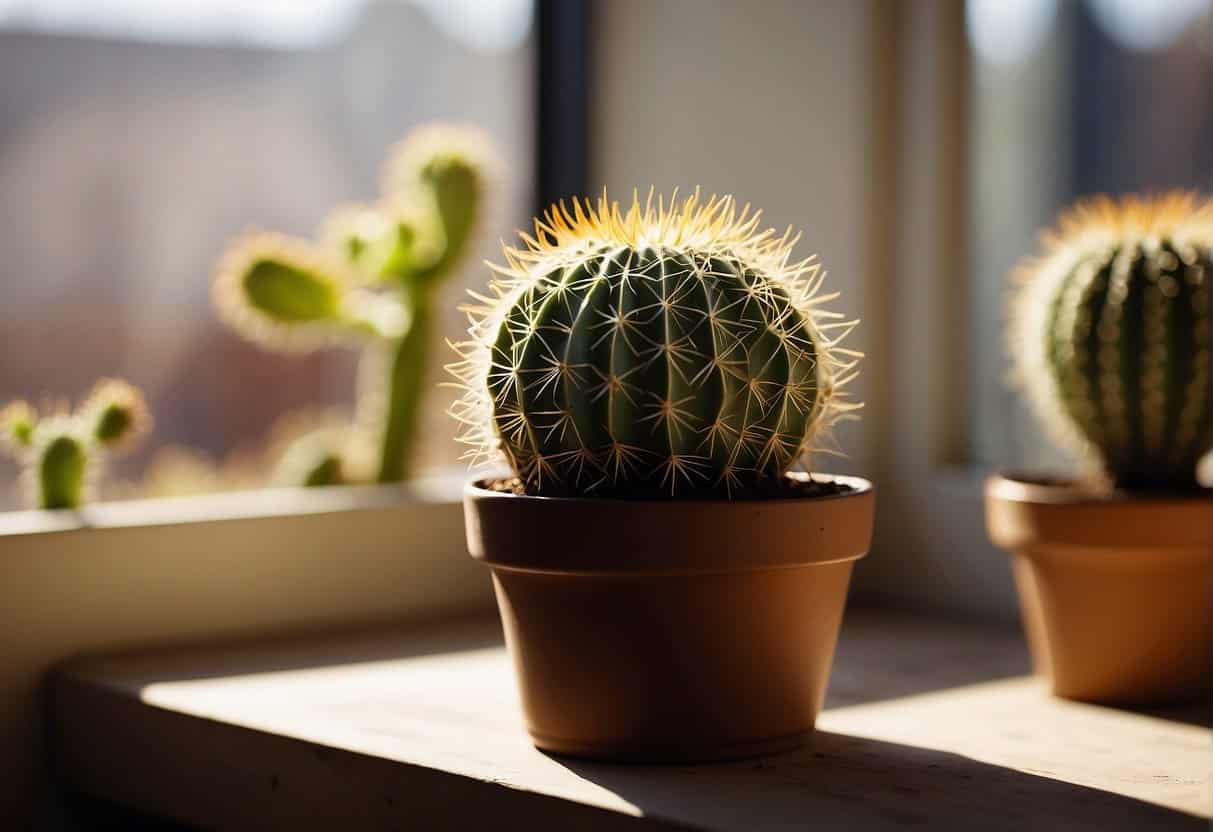
When cultivating cacti in containers, choosing a suitable type of pot and soil mix is crucial for the plant’s health and vigor, as it ensures proper drainage and nutrient availability.
Choosing the Right Container
The choice of container is vital for the well-being of a cactus.
The pot should have adequate drainage holes to prevent water from pooling at the bottom, which can lead to root rot.
Unglazed ceramic pots are generally recommended because they allow the soil to dry out more evenly due to their porosity.
However, one should be cautious not to choose a pot that is too large for the plant, as excess soil can hold water and cause issues.
A pot that is about half an inch larger than the plant is a good rule of thumb.
Understanding Soil Mix and Drainage
The soil mix for a potted cactus should be well-draining to replicate the arid environments in which they thrive.
A commercial cactus soil mix often contains a blend of peat moss, perlite, coarse sand, and sometimes pumice or grit to promote aeration and prevent water retention.
It is essential to avoid regular potting soil, which tends to retain moisture. Adding extra perlite or sand can improve drainage if one opts to make their soil mix.
Proper Watering Techniques
When it comes to keeping a potted cactus healthy, understanding how to water it correctly is essential. Proper watering techniques can prevent issues such as root rot and dehydration, ensuring your cactus thrives.
Identifying Watering Needs
A cactus’s demand for water varies according to the season and ambient light conditions.
During active growth periods in the summer, cacti may require weekly watering. In contrast, when dormant in winter, the watering frequency should decrease, possibly every four to six weeks.
Always check that the top inch of the soil is dry before applying water.
Avoiding Overwatering and Underwatering
Cacti are more susceptible to damage from overwatering than underwatering.
Signs of overwatering include soft, yellowing stems or root rot while underwatering is apparent when a cactus has shriveled or puckered skin.
To avoid these issues, establish a balanced watering schedule and adjust it based on the cactus’s response and environmental changes.
Watering Methodology
There are two main methods of watering cacti: from the top and from the bottom.
Top watering involves watering the soil directly until excess water drains out, ensuring the roots aren’t sitting in water.
Bottom watering is achieved by placing the pot in a saucer of water, allowing the plant to absorb moisture from below; this encourages deep root growth and helps prevent overwatering.
For either method, use water at room temperature to avoid shocking the plant’s roots.
Sunlight and Temperature Requirements
Potted cactus care necessitates a precise balance of sunlight and temperature control. These factors are critical for the cactus’s health and optimal growth.
Managing Sunlight Exposure
Cacti require significant sunlight to thrive, often needing about 4-6 hours of direct sunlight per day.
However, too much direct exposure can harm certain species, with symptoms such as yellowing or bleaching of the plant’s skin.
They have adapted to various light environments, so it’s essential to understand the light requirements for the specific cactus species being cared for.
For instance, low-light varieties will prosper with indirect sunlight, while others might need more intense light conditions.
Maintaining Optimal Temperatures
The ideal temperature range for most cacti is between 65°F and 80°F (18°C – 27°C).
They are adapted to environments with low humidity and can generally withstand a wide range of temperatures, both indoor and outdoors.
However, extreme cold can be detrimental.
Some cacti can tolerate temperatures down to -20°F by reducing water content, but protection is necessary to prevent damage.
Equally important is preventing overheating, which can lead to water loss and heat stress.
Monitoring and adjusting the cactus’s environment during seasonal temperature changes are crucial for its well-being.
Fertilization and Nutrient Management
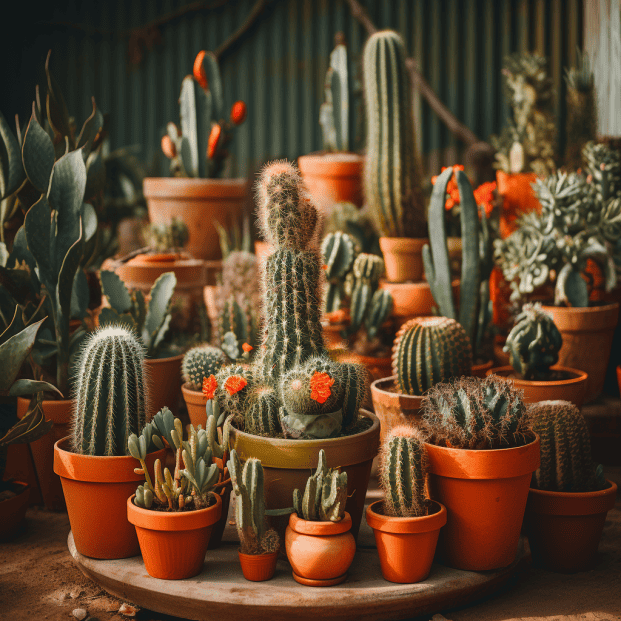
Proper fertilization enhances the growth and vibrant appearance of potted cacti. It’s important to use the correct type of fertilizer and apply it at optimal times to ensure the health of these succulents.
When and How to Fertilize
Potted cacti benefit from fertilization during their active growth phase, typically in the spring and summer months.
Fertilizing cacti once during the beginning of the growing season is recommended. However, for those who are meticulous about scheduling, applying fertilizer two to three times a year—spring, summer, and fall—can be advantageous.
A balanced, slow-release fertilizer ensures nutrients are available without overwhelming the plant.
Less frequent fertilization may be necessary for cacti in smaller pots, as they have less soil from which to draw nutrients.
Frequency:
- Spring: Start of growing season
- Summer: Mid-growth phase (if needed)
- Fall: To strengthen before winter (if needed)
Method:
- Use a slow-release fertilizer
- Apply to moist soil to prevent root burn
- Follow label instructions for quantity
Essential Nutrients for Growth
Cacti require nutrients similar to other plants, with phosphorus being particularly crucial.
Phosphorus is essential for the formation of flowers and fruits and promotes strong root development.
A cactus-specific fertilizer should contain a balanced blend of nitrogen, phosphorus, and potassium, with a higher ratio of phosphorus and less nitrogen, to prevent excessive vegetative growth.
Primary Nutrients:
- Nitrogen (N): Lower ratio for robust growth
- Phosphorus (P): Higher ratio for flower and fruit development
- Potassium (K): Balanced for overall health
Note: Over-fertilization can lead to nutrient burn, evidenced by discolored or withered stems. It is crucial for the grower to avoid excessive fertilizer application.
Pest and Disease Control
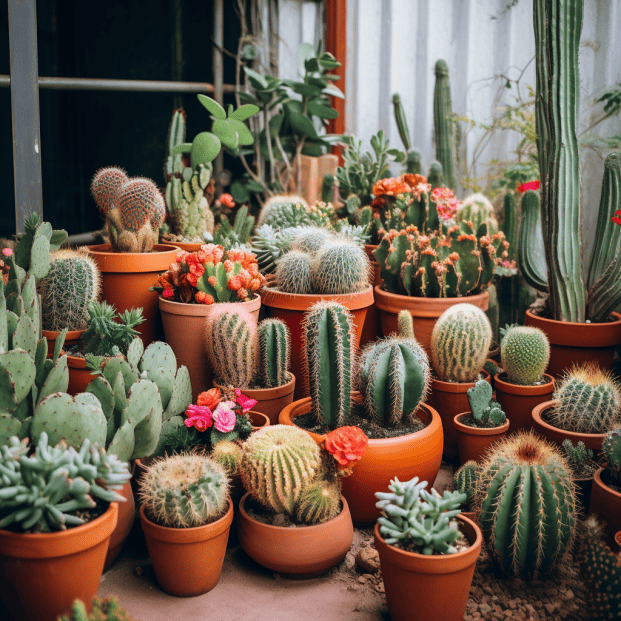
Effective pest and disease control is essential for maintaining the health of potted cacti. Ensuring that these succulents are free from harmful pests and diseases requires an understanding of prevention measures and treatment options.
Dealing with Common Pests
Potted cacti may encounter various pests that can cause significant damage if left unmanaged.
Regular inspections are crucial for early detection and control.
- Mealybugs: These pests appear as small, cottony masses on the cactus. They suck sap from the plant, weakening it. Removing mealybugs can be done by dabbing them with alcohol-soaked cotton swabs.
- Scale insects: Recognizable by their brown or black bumps on cactus skin, these pests also feed on sap. A solution with neem oil can act as a natural deterrent.
- Spider mites: Signs include yellowing leaves and fine webs. An increase in humidity and a miticide can help to control an infestation.
Preventing Fungal and Bacterial Diseases
Fungal and bacterial diseases often stem from improper care. Potted cacti require well-draining soil and should not sit in water.
- Overwatering: The most common cause of cactus diseases, overwatering leads to root rot and fungal growth. Water only when the soil is dry to the touch.
- Poor ventilation: Confined spaces with low airflow can promote the growth of fungi and bacteria. Ensure the cactus is placed in an area with good air circulation to prevent these issues.
- Sterilization: Using sterile soil and clean pots reduces the risk of introducing harmful pathogens. It’s important to sanitize tools before pruning or repotting to prevent the spread of bacterial diseases.
Propagation and Repotting

Caring for potted cacti involves knowing when and how to propagate and repot these resilient plants. Effective propagation can lead to an expanded collection, while repotting is essential for maintaining plant health and encouraging new growth.
Effective Propagation Methods
Propagation is a reliable way to create new cacti from your existing plants. There are two primary methods:
- Offsets: This is when new growth appears at the base of the parent cactus. One can gently remove these using a sharp, sterilized knife once they have a substantial size and their own roots. Offsets should then be allowed to dry and callous over before planting to improve rooting success.
- Cuttings: Taking cuttings involves pruning a healthy section of the cactus and letting it callous. After a few days, the cutting can be placed in a well-draining soil mixture where it will eventually establish roots. Cuttings are suitable for many species but need careful handling to avoid damaging both the cutting and the provider plant.
Safe Repotting Steps
As cacti grow, repotting becomes necessary to provide fresh soil and larger living quarters. To transplant a cactus safely, one should:
- Prepare the Right Soil: Cacti require a special soil mix that drains well to prevent root rot.
- Choose an Appropriate Container: The new pot should be slightly larger than the current one, with ample drainage holes.
- Handle with Care: When handling spiny cacti, use crumpled newspaper, foam, or special tools to protect hands and the plant itself.
The repotting process starts by loosening the soil around the root ball and carefully lifting the plant from its current pot. After removing old soil from the roots, place the cactus in the center of the new pot, and fill it with the fresh soil mix, ensuring that the base of the plant is level with the top of the soil. Water sparingly and keep in a shaded area until the cactus acclimates to its new environment.
Special Considerations for Cactus Varieties
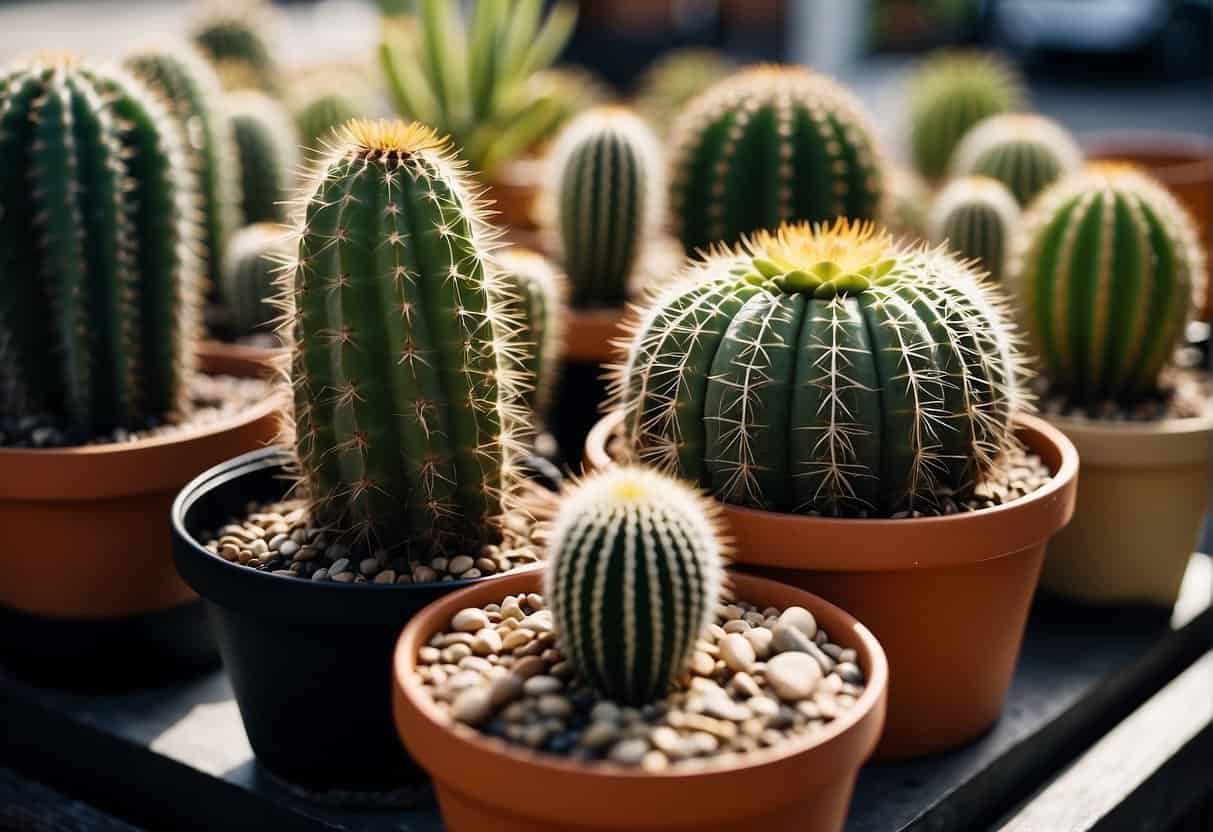
Cactus care varies significantly across different species, each with unique needs in terms of light, temperature, and watering schedules. Knowing these requirements ensures the cacti thrive whether grown indoors or in their natural habitats.
Caring for Desert Types
Desert cacti, such as the saguaro and barrel cactus, demand environments that replicate their natural arid conditions. They should be placed in locations that receive several hours of direct sunlight daily. Adequate drainage is crucial to avoid water retention, which can cause root rot. During hot seasons, watering should be more frequent, but always ensure the soil dries completely between waterings.
Maintaining Indoor Cacti
Indoor cacti, including varieties like the Christmas cactus or bunny ears, often require less intense light. Utilize a grow light if natural sunlight is insufficient, especially for cacti kept in areas far from windows. When watering indoor cacti, allow the soil to become completely dry before adding water. Carefully water from the bottom to encourage the roots to reach downward, promoting healthy growth. Monitoring humidity levels is important as well, as many houseplants might suffer in overly dry indoor air.
Understanding Unique Species Requirements
Certain cacti, such as the moon cactus or old man cactus, have peculiar needs. For example, the moon cactus, which is actually a grafting of two cacti species, may need a more shaded area to prevent the scion from burning. On the other hand, tropical cacti hailing from rainforests, like the Christmas cactus, differ from their desert counterparts and will thrive in more humid and less sunny environments. These species also might benefit from a different soil mix that retains more moisture. Each unique species will have specific guidelines for optimal care—referring to an ebook or care guide can ensure precise requirements are met.
Common Cactus Issues and Solutions
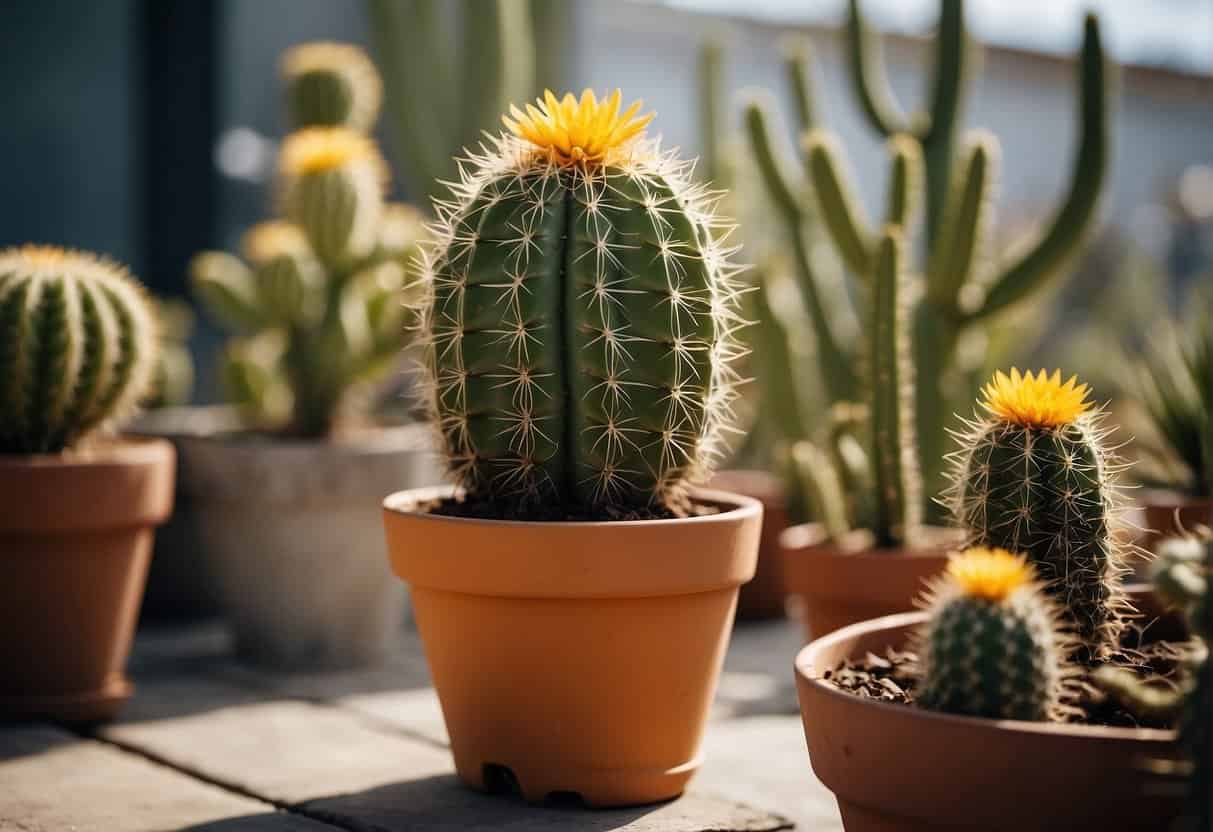
Cactus owners often encounter a few common problems, such as yellowing, wilting, sunburn, and slow growth. Understanding the causes and solutions can help maintain a healthy potted cactus.
Resolving Yellowing and Wilting
Yellowing and wilting in cacti are typically signs of overwatering or underwatering. When a cactus is overwatered, its roots can rot, leading to a yellow and wilted appearance. Conversely, underwatering can cause the plant to dehydrate and turn yellow. To resolve overwatering, allow the soil to dry out completely before watering again. For underwatering, gradually increase the frequency of watering, ensuring the soil is moist but not saturated.
Addressing Sunburn and Discoloration
A cactus can get sunburned when exposed to direct sunlight for too long, which leads to areas of discoloration. To treat sunburn, move the potted cactus to a location with indirect light and avoid sudden changes in sunlight exposure. If the cactus is already sunburned, it can recover if the damaged area is not too extensive and it’s given the proper care to prevent further damage.
Troubleshooting Slow Growth
Slow growth in cacti can be attributed to inadequate light, improper watering, or nutrient deficiencies. Ensure your cactus is receiving enough light and adjust watering schedules to the specific species’ needs. If underwatering is suspected, increase the water slightly. Fertilizing during the growing season can also promote healthy growth, but this should be done sparingly, as too much can harm the cactus.
Seasonal Care and Growing Conditions

Proper seasonal care ensures that potted cacti remain healthy and vibrant throughout the year. Understanding how seasonal changes affect light, temperature, and moisture is crucial for cultivation success.
Cactus Care Throughout the Seasons
Spring and Summer:
- Light: Cacti should receive up to 12 hours of bright sunlight daily to mimic their natural habitat.
- Watering: Water your cacti roughly every week, but always check the soil drainage first to ensure the well-drained soil is dry.
Fall and Winter:
- Light: A sunny location is still important, but cacti require less intense light.
- Watering: Reduce watering frequency to every four to six weeks as cacti enter a dormant period.
Adjusting Care for Humidity and Rainfall
High Humidity:
- Ventilation: Ensure good airflow to combat high humidity, as excessive moisture can cause rot.
- Shade: Provide some shade to prevent water from accumulating too quickly in the soil, especially in a humid garden setting.
Rainfall:
- Ensure potted cacti are undercover or brought indoors during heavy rainfall to maintain control over watering and prevent soil from becoming waterlogged.
Frequently Asked Questions


Proper care of potted cacti involves addressing specific needs regarding watering, disease management, lighting, seasonal care, and treatment of common issues. These targeted FAQs provide the essential practices for maintaining healthy cacti.
What are the correct watering techniques to keep a cactus healthy?
Cacti require less water than many other houseplants and benefit from thorough watering only when the soil is completely dry. Utilizing bottom watering techniques can help ensure that the water reaches the roots effectively without leaving excess moisture on the surface, which can lead to problems.
How can I identify and treat common diseases in cactus plants?
Common cactus diseases include fungal infections that often manifest as dark spots or rot. Early identification and treatment involve removing the affected area and treating it with a suitable fungicide. More details on disease prevention and treatment can be found in a comprehensive guide to cactus care.
Which are the best indoor locations for potted cacti to thrive?
Cacti thrive in areas with bright, indirect sunlight. A south-facing or east-facing window is often ideal. It is critical to avoid direct sunlight that can scorch the plants and to provide adequate ventilation to mimic their natural arid habitat.
What care adjustments are needed for cactus during winter months?
During winter, cacti enter a period of dormancy and require less watering. The temperature should be cooler, and the watering frequency should be reduced.
They should be protected from drafts and not placed near heat sources that may dry them out too quickly.
How do you recognize and resolve overwatering issues in cacti?
Signs of overwatering in cacti include yellowing or translucent skin, softness, and rot.
To resolve these issues, reduce the watering frequency, ensure the pot has drainage holes, and consider repotting the cactus in fresh, fast-draining soil if necessary.
What are the guidelines for choosing and caring for a mini cactus?
Mini cacti require care similar to that of larger varieties. However, they are more susceptible to overwatering due to their small size.
Choose a pot with appropriate drainage. Then, opt for a soil mix specifically designed for cacti. Lastly, water sparingly to maintain the health of a mini cactus.

